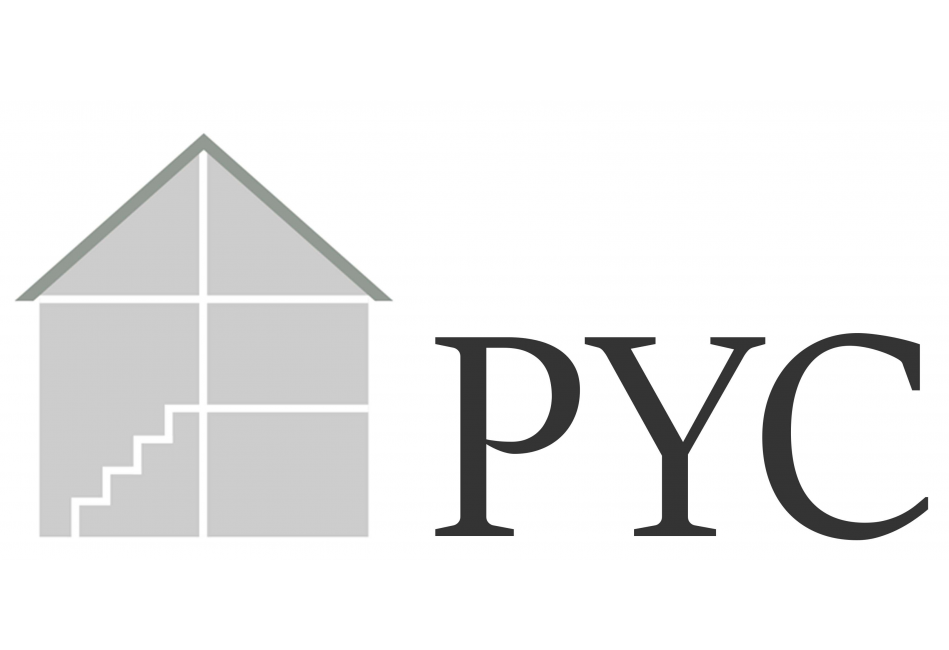
- New build
- Posted
Office romance - Passive house supplier walks the walk with new office & factory
When Welsh sustainable building specialists PYC decided to start making their own timber frames, they got down to work designing and building their own factory. Once that was finished, it was time to test their system on their first order: to build their own passive house certified offices right next door – and to be bold enough to decide not to install central heating.
Click here for project specs and suppliers
£47 per month (estimated space heating cost – but the real figure is likely far lower)
Building: 220 m2 office building
Location: Welshpool, Powys
Build method: Timber frame
Budget: £350,0000
Standard: Passive house certified
Welsh firm PYC are a bit of a sustainable building juggernaut, with separate divisions specialising in insulation, airtightness, and the design of low energy, timber frame buildings.
“We started thinking about building new premises several years ago because we’d outgrown the previous office space,” says the company’s managing director, Jasper Meade. “We also had no manufacturing capability to build our own timber frames and we were struggling to outsource the new specifications we’d introduced.”
In 2014, the company found a greenfield site on an industrial estate in Welshpool, just a few miles from their old offices. As well as the fast transport links, staff could continue to live locally. Meade made preliminary sketches for the entire site on a train journey to London one day. The most important elements, he felt, were a factory containing a small office and observation room, a larger separate office building, car park, outside storage, meeting room, kitchen and toilets.
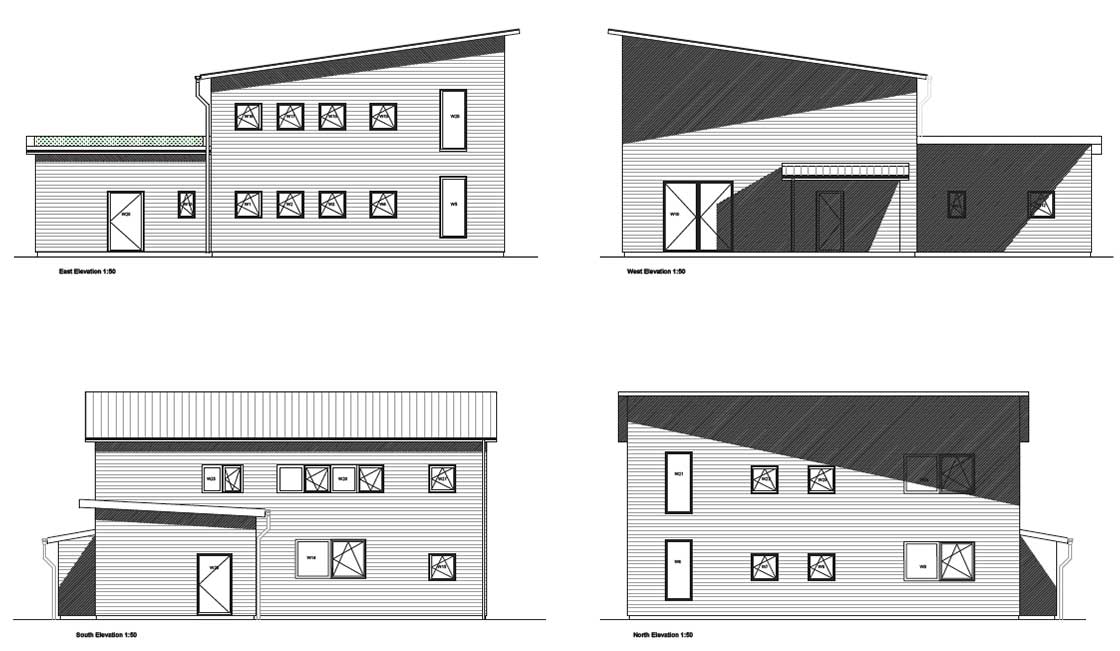
This article was originally published in issue 32 of Passive House Plus magazine. Want immediate access to all back issues and exclusive extra content? Click here to subscribe for as little as €10, or click here to receive the next issue free of charge
As a company with long-term growth plans, PYC also needed space to breathe, he felt. “The hardest challenge was futureproofing the building. We had to make sure there was room for expansion in both the factory and the offices.”
But it turned out to be much trickier than Meade anticipated to get the project off the ground. PYC applied for planning permission for the whole site in 2014, but it wasn’t achieved until 2016, when the company finally bought the land and started building the factory.
“It was surprisingly hard to get all the finance and planning approvals, including environmental and noise assessments and all the financial forecasts so we could be sure the plans would work,” Meade says.
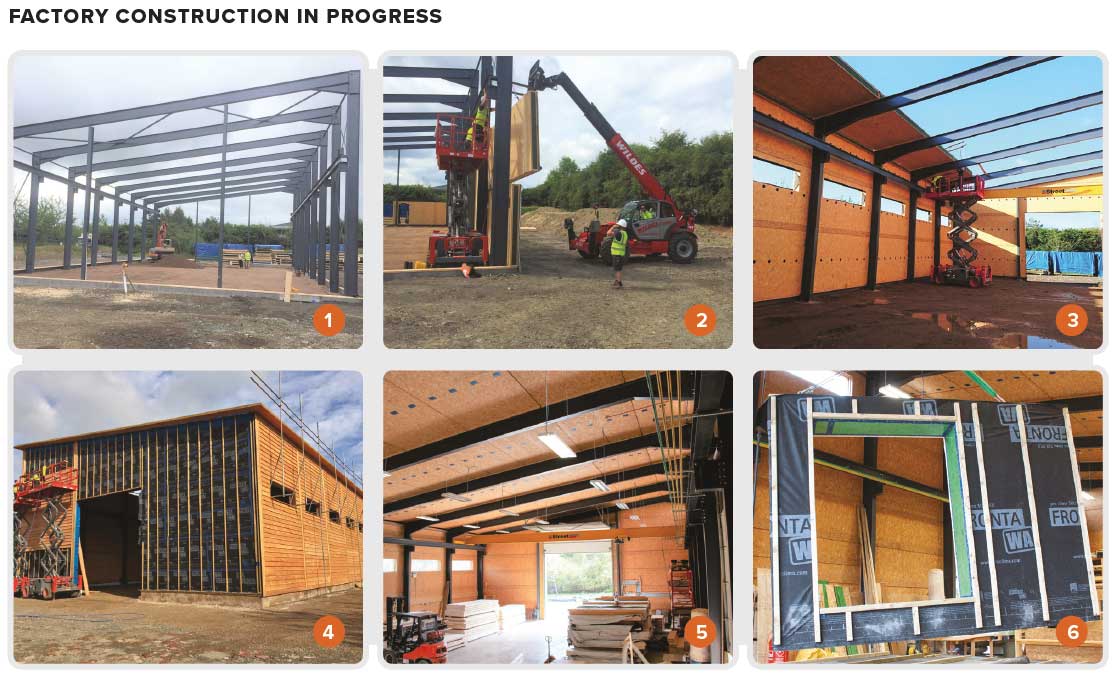
1 The factory was built using PYC’s closed panel system wrapped around a steel portal frame; 2 erection of the closed panel system for the walls; 3 the roof panels being fitted into place; 4 PYC workers clad the factory with locally sourced Welsh Douglas fir; 5 interior of the factory; 6 close up of one of the panels, with airtightness taping and Solitex Fronta WA breather membrane.
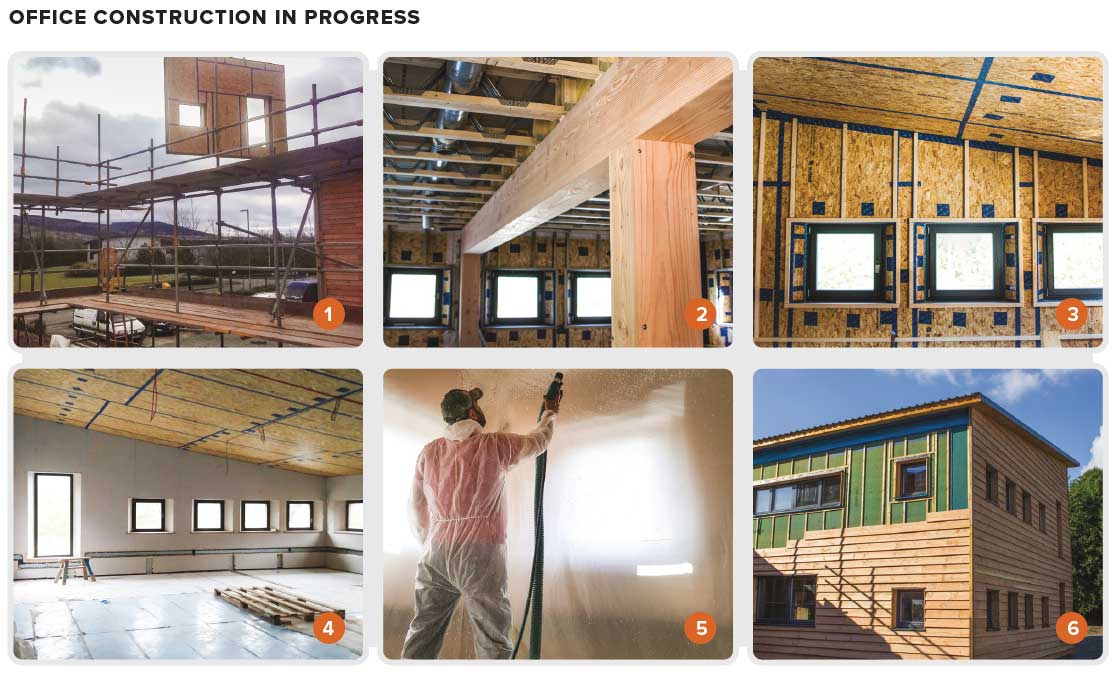
1 A crane lifts a wall panel into place; 2 the build used Douglas fir “Ty Unnos” box beams; 3 OSB taped at all joints with pro clima Tescon Vana; 4 Gyproc plasterboard fitted to interior walls; 5 applying the Soundcel (sprayed recycled newspaper) acoustic insulation to the ceiling of the first floor office; 6 external walls feature 25 mm Isoplaat woodfibre board and 20 mm Welsh Douglas fir horizontal cladding.
Surprisingly, the greatest stumbling block proved to be the Welsh government’s uncertainty about whether passive house was an acceptable standard to build to (specifically, PYC were asked whether passive house is as good a standard as BREEAM – and given that the former focuses on operational energy use and indoor air quality, while the latter is a more general green building certification, the question isn’t really comparing like with like).
But Meade has always been a passionate believer in changing minds through educating people about sustainable buildings The PYC team, he says, did a good job in “demonstrating to the government that the energy performance of this standard superseded all others”, with some help from leading passive house design firm Architype, and the Welsh government ultimately gave the green light.
Work began to put up the factory in 2016. PYC hired a nearby yard, where they built the frames for the factory. Nine months later, the factory was up and ready to start producing its own timber frames. So the PYC team turned their attention to their new office building.
“After we’d made the panels in the factory, it took just a couple of weeks to put them up, but then the internal works took months, including electrics, plumbing and external finishes. We mostly used the PYC team for construction, which slowed us down because they could only be on site when not working on other projects.”
Meade says that PYC’s decision to build the office to the passive house standard was a “natural progression” given the company’s tradition of sustainable building. In 2016, PYC ran a passive house designer training course which two of the company’s employees attended.
Afterwards, Meade gave them the task of designing the new office building.
“We felt building the offices to passive house standards would exemplify the work we do,” he says. “But there were other major benefi ts, too, such as being cheap to run, comfortable and healthy for workers. After all, we all tend to spend more working hours in the office these days.”
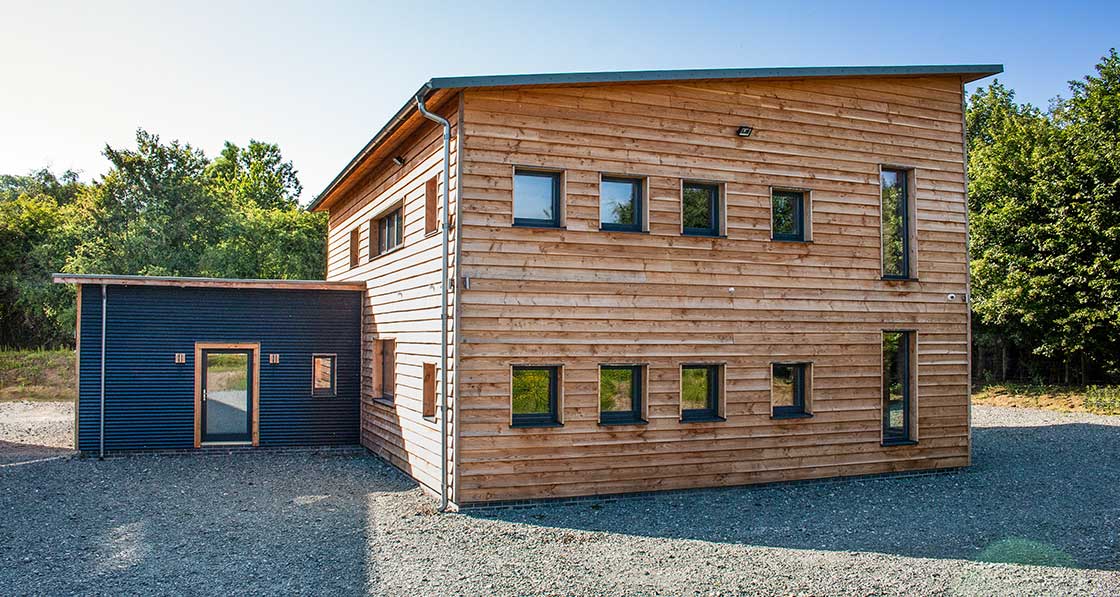
We felt building the offices to passive house standards would exemplify the work we do.
For many years, PYC used twin frame and Larson truss systems, but they chose to experiment with a new approach, building both the factory and the office with an I-beam system.
“I-beams are a highly engineered component with multiple size options available, giving us the option of the variables we need to cover for the design space, as well as U-value options,” Meade says. “This offers us a single stud frame system which is economical in timber use yet maintains the high performances that we required.”
After several design and engineering revisions, I-beam has now become PYC’s standard construction method. “Looking back today after three years of using the I-beam system in the factory, our experience has been that it creates a comfortable working environment and real benefits in energy performance,” says Meade.
The company’s love of timber also influenced the office designs, and there are many wooden features in the internal spaces, the vast majority of it in Welsh timber. For example, PYC installed wooden supporting posts and beams for the floor, and Welsh spruce glulam walls They chose poplar internal lining boarding and birch end-grain flooring. Meanwhile, the external walls were clad with more than 7 km of Douglas fir weather boarding.
None of the PYC staff had experienced living or working in a passive house environment before, and both performance and comfort exceeded everyone’s expectations. “We consider our office very much a living space, making the comfort, health and wellbeing of all who work here important,” says Meade. “The materials we used are the key to making this work.
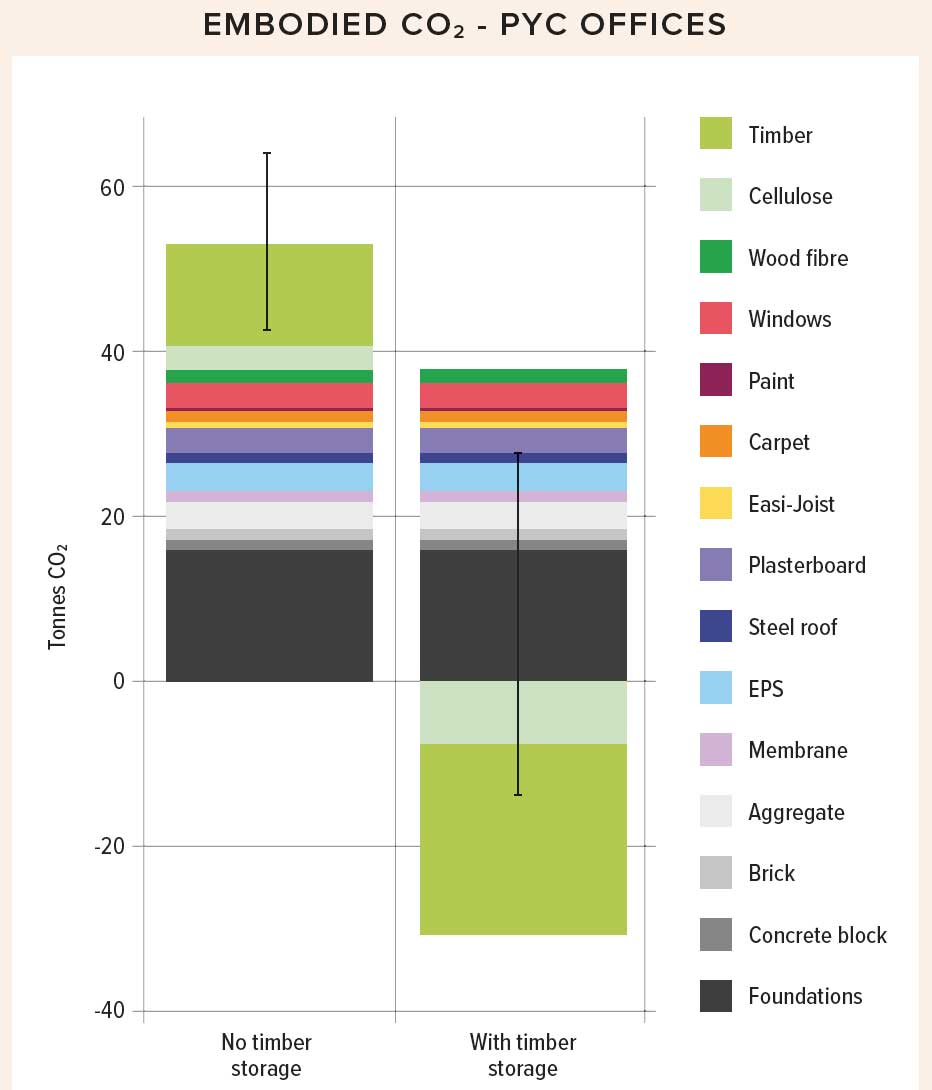
The above graph shows the embodied carbon for the PYC offi ces, broken down by component materials. The graph on the left does not include the carbon stored in the timber; the graph on the right does. The one on the right shows that the carbon storage for the building materials is similar in scale to the emissions of manufacture, however an official calculation (by RICS guidelines) would also need to include the end of life stage, which may involve re-release of CO2 via burning and/or decay, or continued storage if the timber can be reused or recycled. There is still debate about how and when carbon storage in timber products should be counted, for various reasons. For example, some natural carbon stores (such as peat soils) may have been disturbed during afforestation, and of course there is uncertainty over how soon the carbon will be returned to the atmosphere at the end of the material/building’s life. Graph calculated by Tim Martel using the PHribbon plugin for PHPP.
Specifically, the Warmcel [cellulose insulation] in the walls and roof offers stable temperatures, providing thermal comfort in summer and winter.”
PYC’s employees moved into the office shortly before the exceptionally hot 2018 summer, which saw regular ambient temperatures of 28C, and higher peaks. It took a while to get to grips with the MVHR system, but the team spent many summer days working with windows open. “This felt right for us and it dispelled the common misconception about never opening windows in a passive house,” Meade said.
“With over 31C outside we never got above 26C inside.”
The winter of 2018 was comfortable in the office too, Meade says The team logged daily temperatures for several locations on the premises, and readings showed consistent average internal temperatures of 21.5C. On the rare occasions when the office temperature dropped to around 15C following a weekend of sub-zero weather, a small electric heater soon fixed the problem on Monday morning. The heater was barely required again for the rest of the week.
In keeping with the true spirit of the passive house standard, the team had decided not to install any conventional central heating system. “This was always the plan,” Meade says. “Typically, our customers fit a ‘just in case’ system such as underfloor heating or even a small log stove. We knew from experience that this would be unnecessary, now we can prove it!”
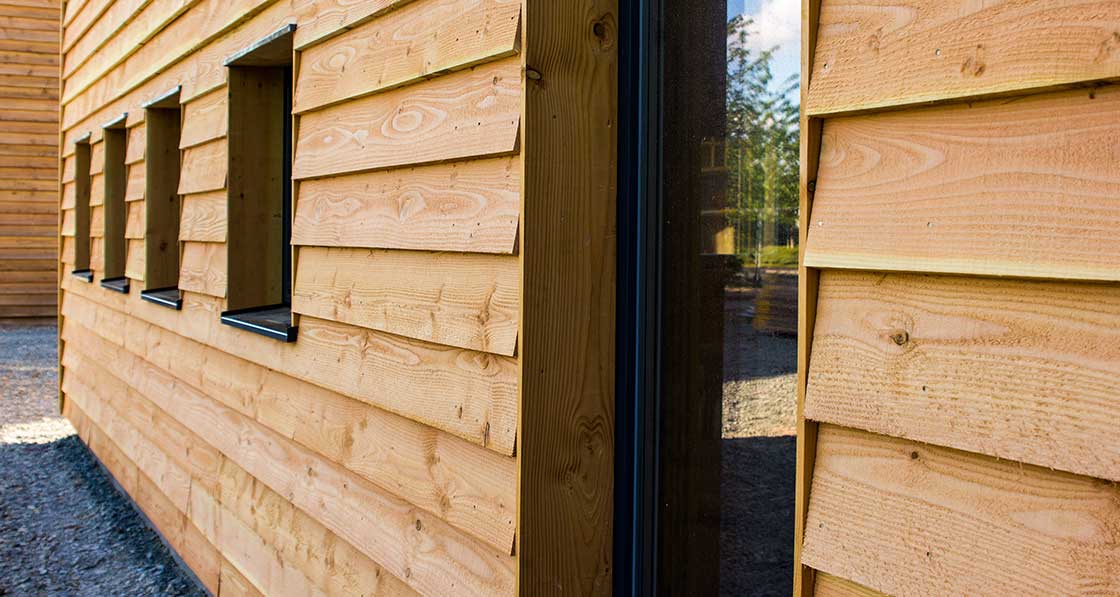
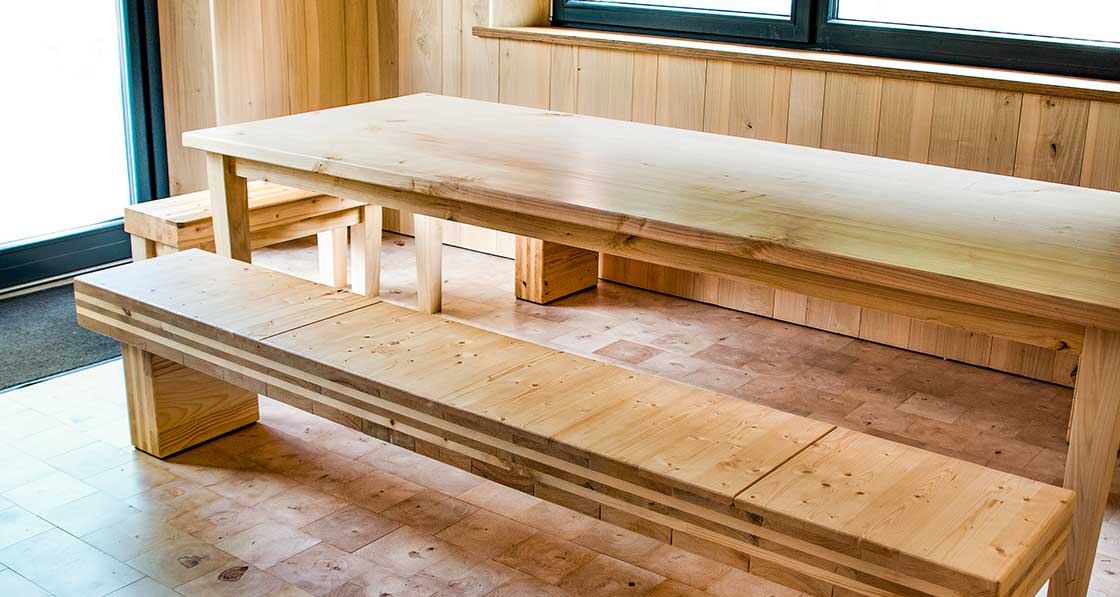
The final airtightness test result on the office building was 0.5 air changes per hour. PYC carried out airtightness tests before and after the installation of the Warmcel, and noted a 24% improvement in the result. “This wasn’t surprising news to us as we already knew it was full-fill, knit fibre and high-density. Warmcel shouldn’t be relied on to provide airtightness, but it certainly helps,” Meade says.
PYC also spent a lot of time testing the application of Soundcel sprayed-cellulose acoustic insulation on the ceiling of the first-floor office. Getting the mix and texture right called on all their experience, but the results were worth it in the end.
“Such an open space has a risk of echo, but the textured finish of the Soundcel on such a large area reduces any sound resonance,” says Meade. “A simple mix of Soundcel and PVA glue sprayed to a depth of 15 to 20 mm also gave the office a different feel to a conventional plasterboard finish.”
Final Passive house certification was not achieved until April 2019, but the entire process provided invaluable lessons. “We learned a lot during the construction of the offices as it allowed us to develop, trial and review all our processes and systems.
For example, we learned important lessons about design detailing, on-site construction and erecting I-beams,” Meade says.
Working out of their Welshpool office allows PYC to show off the advantages of passive house construction and low-energy timber frames. Meade says the company likes to invite prospective clients into the space, including self-builders, architects, local authorities, as well as local businesses and schools.
“We’re also keen to share what we’ve learned about passive house and energy efficient building. We’re already working with the Welsh government and we’re helping to train the next generation of architects and designers, as well as making links with local colleges.”

Selected project details
Client: PYC Group
Architect: PYC Design
Main contractor/timber frame/M&E engineer: PYC Construction
Structural engineer: Bob Johnson Structural Engineers
Mechanical contractor: Steve Smith Plumbing & Heating
Electrical contractor: Maden and Powys Electrical
Airtightness testing: PYC Systems
Wall insulation: Warmcel, via PYC Insulation
Additional wall insulation: Isoplaat woodfibre board
Thermal breaks: Compacfoam, via Green Building Store
Floor insulation: Boys & Boden
Airtightness products: pro clima, via PYC Systems
Windows & doors: Green Building Store
MVHR: Systemair
Furniture: Kenton Jones Ltd
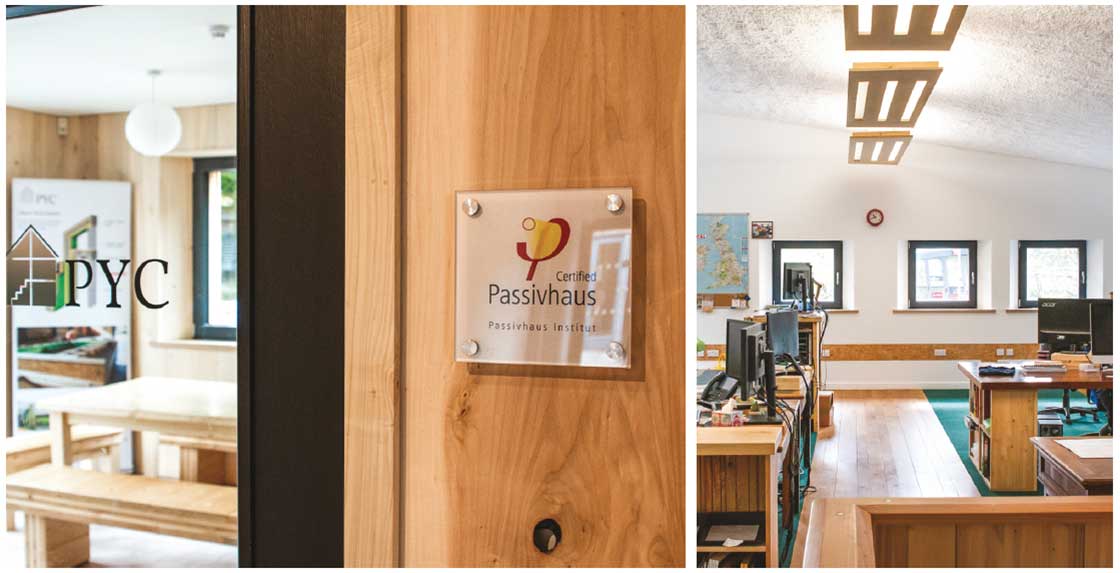
In detail
Building type: 220 m2 timber frame office
Location: Welshpool, Powys
Completion date: May 2018
Budget: £350,000
Passive house certification: Passive house certified (classic standard)
Space heating demand (PHPP): 14 kWh/m2/yr
Heat load (PHPP): 10 W/m2
Primary energy demand (PHPP): 134 kWh/m2/yr
Heat loss form factor (PHPP): 3.2
Number of occupants: Around 10 employees
Overheating (PHPP): 3%
Airtightness (at 50 Pascals): 0.5 ACH (n50) or 0.62m3/m2/hr (q50)
Measured energy consumption & bills: The office & factory are on the same electricity meter, so it is difficult to separate heating energy consumption from manufacturing etc. All space heating and hot water is met via mains electric. This is with the intention of introducing a large array of PV panels which will provide all the power required to make the offices off-grid in future. As per PHPP calculations for the office building only, total space heating demand is 3,024 kWh/a. Hot water demand is 2,584 kWh/a and is met via an instantaneous electric water heater and shower. Non-residential electric demand of 3,233 kWh/a. Total energy demand: 8,841 kWh/a. Currently with an electric tariff of 18.8p per kWh this would provide an estimated annual electric bill of £1,662 of which £568 would be for space heating (not including standing charges). However, as in practice all space heating is met via a small 1kW portable electric heater, the actual amount is likely to be far less.
Thermal bridging: PYC Design undertook detailed design to ensure cold bridge-free design.
Ground floor: 20 mm engineered oak flooring (entrance lobby) / 10 mm Welsh birch end grain cobbles (GF dining room), VOC-free carpet (Offices). Timber finished with OSMO oils. 200 mm reinforced concrete slab on DPM, on 300 mm of EPS insulation under slab and 200 mm EPS perimeter insulation, on 50 mm sand blind, on Type 1 compacted hardcore. U-value: 0.116 W/m2K
Walls: 20 mm Welsh Douglas fir horizontal cladding externally, fixed to 25x50 mm treated horizontal battens on 25x50 mm treated vertical counter battens providing ventilated cavity, followed inside by pro clima Fronta WA breather membrane taped at joints with pro clima Tescon Vana, 25 mm Isoplaat woodfibre board, 400 mm Masonite I-beam studs @ 600 mm c/c, fully filled with Warmcel cellulose fibre insulation, 15 mm OSB taped at all joints with pro clima Tescon Vana, 50x50 mm service batten, 12.5 mm Gyproc plasterboard, skim and low VOC white emulsion or Welsh poplar timber cladding. U-value: 0.10 W/m2K
Mono pitched roof: Powder coated box profile steel roofing sheets externally, fixed to 75x50 mm treated battens, followed inside by 25x50 mm treated CLS counter battens. This makeup created, drainage, ventilated cavity and overhang, pro clima Solitex Plus laid over 25 mm Isoplaat woodfibre board, 400 mm I-beam rafters @ 600 mm c/c, fully filled with Warmcel cellulose insulation, 15 mm OSB taped at joints with pro clima Tescon Vana, Soundcel (sprayed recycled newspaper) acoustic insulation. U-value: 0.092 W/m2K
Flat roof: Baileys Atlantic single ply membrane laid over 18 mm WBP plywood decking, fixed to 50x50 mm treated battens, followed inside by pro clima Solitex Plus laid over 25 mm Isoplaat woodfibre board, 400 mm I-beam rafters @ 600 mm c/c, fully filled with Warmcel cellulose insulation, 15 mm OSB taped at joints with pro clima Tescon Vana, Soundcel (sprayed recycled newspaper) acoustic insulation. U-value: 0.092 W/m2K
Windows & external doors: Green Building Store Ultra triple glazed timber framed windows. Passive House Institute certified. Sealed with pro clima tapes. Overall U-value: 0.79 W/m2K
Heating system: No primary heating. Small 1kw moveable heater. Direct electric heating for domestic hot water.
Ventilation: PHI certified Systemair VTC 700 MVHR system. Efficiency 77% (PHI).
Shading: Large roof overhang.
Green materials: Use of locally sourced Welsh timbers, including external Douglas fir cladding, internal Poplar cladding to walls, Birch endgrain flooring, bespoke made Welsh spruce CLT internal walls and Douglas fir “Ty Unnos” box beams. Recycled newspaper cellulose fibre insulation (Warmcel). Low VOC finishes, paints and oils.
Image gallery
-
 Factory-Final-design
Factory-Final-design
Factory-Final-design
Factory-Final-design
-
 BR346
BR346
BR346
BR346
-
 C004-Elevations
C004-Elevations
C004-Elevations
C004-Elevations
-
 C006-Sections-and-details-150217-B
C006-Sections-and-details-150217-B
C006-Sections-and-details-150217-B
C006-Sections-and-details-150217-B
-
 Factory-and-office-Design
Factory-and-office-Design
Factory-and-office-Design
Factory-and-office-Design
-
 Site plan
Site plan
Site plan
Site plan
-
 TF009-Details-291216
TF009-Details-291216
TF009-Details-291216
TF009-Details-291216
https://passivehouseplus.co.uk/magazine/new-build/office-romance-passive-house-supplier-walks-the-walk-with-new-office-factory#sigProIdeeb3814031





